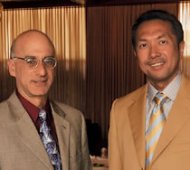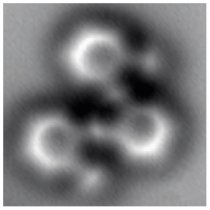
Banking on the future of small things
Thanks to what Dean Daniel Pitt describes as "a gift with vision, " SCU’s School of Engineering is launching a Center for Nanostructures, designed to help industry close the gap between current university-level education and the burgeoning nanoscience and nanotechnology fields. The new center will focus on interdisciplinary research in selected areas of nanoscale science and technology and will develop pioneering curricula that integrate learning with research.
Nanotechnology and nanoscience are fast-growing and impactful disciplines.
John Ocampo ’79 and his wife, Susan, have made a $1.3 million pledge to provide start-up funding for the new center. John Ocampo is a co-founder and chairman of Sirenza Microdevices and was formerly its CEO. He is a member of the School of Engineering’s Industry Advisory Board. Susan Ocampo is a co-founder of the company and is its treasurer. When the couple’s gift, which is part of Santa Clara’s current fund-raising campaign, was publicly announced early in May, John Ocampo said, "I am excited to be a part of Santa Clara’s new role in nanoscience research. The potential benefits of this technology are far reaching and match up with the University’s values, which I am proud to support."
 Cary Yang, an associate dean of engineering and a long-time nanostructures researcher who came to SCU in 1983 from the NASA Ames research program, will head the center.
Cary Yang, an associate dean of engineering and a long-time nanostructures researcher who came to SCU in 1983 from the NASA Ames research program, will head the center.
Small scale, huge impact
Nanotechnology and nanoscience are fast-growing research and industry disciplines, Yang notes. "Physical, chemical, electrical, mechanical, magnetic, optical, and other properties change in many cases as nanoscale is approached. Nanotechnology takes advantage of what happens to these materials at extremely small scale, where they produce novel phenomena and properties."
Engineering Dean Daniel Pitt, left, with John Ocampo ’79, who recently pledged $1.3 million to provide start-up funding for SCU’s Center for Nanostructures.
Yang notes that these new and unusual properties ultimately will have a huge impact on society through computing, communication, information storage, health care, energy, and a wide range of other areas.
"Nanotechnology is potentially as enabling as railroads, automobiles, and computers were, " he says.
Yang, who says he has been "looking at small things" professionally since 1976, is engaged in research on the interfaces between nanostructures—the wires on computer chips being one example. Those tiny—and getting smaller-—wires are becoming the dominant factor in on-chip performance as well as reliability, Yang says. His work at Santa Clara has brought in gifts and grants for research from the National Science Foundation, NASA, and various companies.










